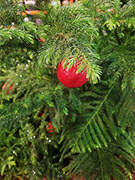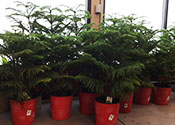 While walking in the seasonal section in the store the other day, I noticed a Norfolk Island pine all dressed up for Christmas. With its soft needles, wonderful texture and unique form, I just knew it had to be my living Christmas tree this year. Not only will I get to enjoy it for the holidays, but I will also get to keep it as an addition to my ever-growing collection of houseplants.
While walking in the seasonal section in the store the other day, I noticed a Norfolk Island pine all dressed up for Christmas. With its soft needles, wonderful texture and unique form, I just knew it had to be my living Christmas tree this year. Not only will I get to enjoy it for the holidays, but I will also get to keep it as an addition to my ever-growing collection of houseplants.
Maybe you were tempted by the unique Norfolk pine as well, or was gifted one for the holidays. But, how do you take care of your new houseplant when the holiday season is over?
When it comes to care, Norfolk Island pines are actually quite easy as long as they receive good, consistent care.
Interestingly enough, Norfolk Island pines are not actually pines at all. They are from an ancient plant family of conifers named Araucariaceae dating back to the prehistoric age and currently found only in the Southern Hemisphere. Norfolk Island pines are named after Norfolk Island, where they were first found, located in between Australia and New Zealand.
In their native habitat, Norfolk Island pines get bright light, mild temperatures and high humidity. They are adapted to tolerate high saline soils and can stand a build-up of fertilizers, making them excellent as houseplants.
The best location for your new houseplant is in a large south-, east- or west-facing window with lots of indirect and direct light. If you do not have a window with lots of light, consider keeping the room light on for longer periods of time during the day. You will want to rotate your plant regularly to ensure your pine is healthy and upright, especially if you want to use it as a living Christmas tree next year too.
Your home’s normal temperatures (55 to 70 degrees Fahrenheit) are usually good for Norfolk Island pines, though try to avoid extreme temperature disparities. During the winter nights, make sure the air temperature does not drop below 50 degrees F as these plants may become damaged.
Like many of our houseplants originating from subtropical climates, Norfolk Island pines prefer higher humidity at or around 50 percent. Particularly in the winter, our Nevada homes do not offer this level of humidity. So, you can try a humidifier nearby to raise the humidity or simply place the plant on a pebble tray with water to ensure the humidity remains high.
 Watering is critical, and you will know to water when the top inch of soil feels dry. You want the soil to be moist, but never wet. Use a sand, peat moss or other mix that offers good drainage. When you first bring your Norfolk Island pine home, pay attention to the pot size, pot type, plant size, room temperatures and humidity to get the best watering schedule for your plant.
Watering is critical, and you will know to water when the top inch of soil feels dry. You want the soil to be moist, but never wet. Use a sand, peat moss or other mix that offers good drainage. When you first bring your Norfolk Island pine home, pay attention to the pot size, pot type, plant size, room temperatures and humidity to get the best watering schedule for your plant.
If you are decorating your plant for the holidays, make sure to use lightweight ornaments and lights as the Norfolk Island pine’s branches are quite soft. And if you are using lights, we recommend using LED so as not to burn the foliage. Lastly, you will want to remove any decorations soon after the holidays to prevent damage to the needles or branches.
Follow these steps for care, and you will be able to enjoy your new houseplant for years to come!
Fisher, J.
2017,
Norfolk Island pine: a living Christmas tree,
Reno Gazette Journal


